
Tuen Mun District is one of the 18 administrative districts of Hong Kong. It is the westernmost continental district of Hong Kong. It had a population of 487,546 in 2011. Part of the district is the Tuen Mun New Town, which contains one of the largest residential areas in the New Territories.
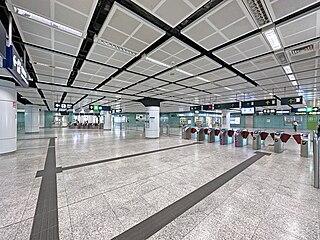
Siu Hong is an MTR station located beside Siu Hong Court, Tuen Mun, New Territories, Hong Kong. It is built on the Tuen Mun Nullah immediately east of Siu Hong Court. The station is on the Tuen Ma line between Tin Shui Wai and Tuen Mun stations. Elevated public transport interchanges are provided at both the south and north ends of the station. Two access ramps link the public transport interchanges to Castle Peak Road and Tsing Lun Road for access to feeder services such as buses, minibuses, and taxis.

Hong Kong Central Library is the largest library in Hong Kong, flagship library of Hong Kong Public Libraries (HKPL) and used as Hong Kong Public Library headquarters, functioning as the territory's National Library. It is located at the intersection of Moreton Terrace and Causeway Road in Causeway Bay.
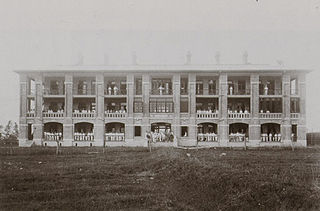
Lingnan University was a private university from 1888 to 1952 in Guangzhou, Guangdong, China. It was established by a group of American missionaries in 1888 as the Canton Christian College (格致書院).

Lingnan University is a public liberal arts university in Tuen Mun, New Territories, Hong Kong. It aims to provide students with an education in the liberal arts tradition and has joined the Global Liberal Arts Alliance since 2012. It has a rich heritage that dates back to its founding in Guangzhou in 1888. Known in its earlier years as Lingnan Xuexiao and subsequently as Lingnan University, the institution flourished in the field of higher education until 1952. It was reborn in Hong Kong in 1967.
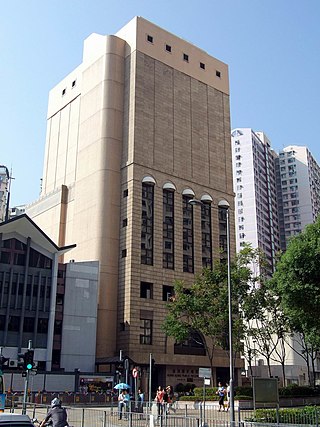
Government Records Service (GRS) is the central records management service agency of the Hong Kong Government. It aims to be the most insightful, resourceful and leading public archives in Hong Kong. The department is subordinate to the Administration Wing of the Office of the Chief Secretary for Administration.

Tuen Mun or Castle Peak is an area near the mouth of Tuen Mun River and Castle Peak Bay in the New Territories, Hong Kong. It was one of the earliest settlements in what is now Hong Kong and can be dated to the Neolithic period. In the more recent past, it was home to many Tanka fishermen who gathered at Castle Peak Bay. Tuen Mun is now a modern, mainly residential area in the north-west New Territories. As of 2011, 487,546 live in Tuen Mun and over 95% of them are Chinese.

In Hong Kong, the Land Registry is a government department under the Development Bureau responsible for the administration of land registration. It also provides facilities for search of the Land Register and related records by the public and other government departments.

Tuen Mun Ferry Pier (屯門碼頭), or Tuen Mun Ferry Terminal, is a public pier located in the southern area of Tuen Mun, Hong Kong.

Tuen Mun New Town, commonly referred to simply as Tuen Mun, is a satellite town of Hong Kong. It is one of the new towns that were developed by the Hong Kong Government in the New Territories from the 1960s. It was built around the existing rural local centre of Tuen Mun. The new town covers most of the urban area of Tuen Mun District.
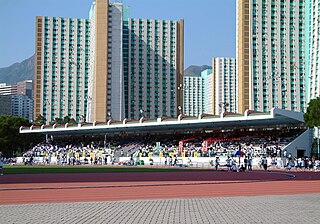
Tuen Mun Tang Shiu Kin Sports Ground is a multi-use stadium in Hong Kong. It is operated by Leisure and Cultural Services Department of Hong Kong. It is currently the home of Hong Kong Premier League club Rangers.
The Hong Kong Institute of Vocational Education (IVE) is one of the member institutions of the Vocational Training Council (VTC) offering vocational education to post-secondary students in Hong Kong through its nine campi located across the territory.

Tuen Mun Park, formerly known as Tuen Mun Town Park, is located in Tuen Mun, Hong Kong. It is the largest town park in the New Territories, covering 12.5 hectares.

Tuen Mun San Hui more commonly known as just San Hui (新墟) is an area of Tuen Mun District, Hong Kong and is a major food market and commercial quarter in the district. In urban planning, it is part of Tuen Mun New Town.
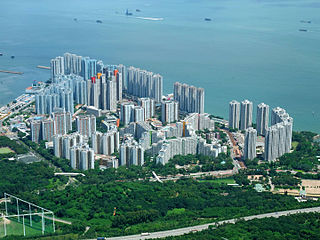
The following is an overview of public housing estates in Tuen Mun, Hong Kong, including Home Ownership Scheme (HOS), Private Sector Participation Scheme (PSPS), Sandwich Class Housing Scheme (SCHS), Flat-for-Sale Scheme (FFSS), Subsidised Sale Flats Project (SSFP), and Tenants Purchase Scheme (TPS) estates.

Tuen Mun Town Plaza is the largest shopping mall in the NW New Territories of Hong Kong. Established in 1988 and located in the town of Tuen Mun, it was developed by the Sino Group. It provides a large range of merchandise, offering residents a myriad of shopping, dining and entertainment facilities.
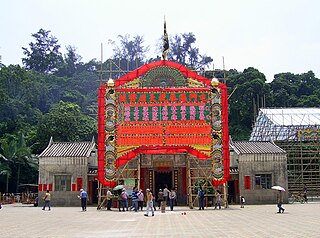
Hau Kok Tin Hau Temple is a Tin Hau temple in Tuen Mun, Hong Kong.

Miami Beach Towers is a private housing estate located in Tuen Mun, New Territories, Hong Kong near Light Rail Tuen Mun Ferry Pier stop. It was built by Sino Land on land reclaimed from Castle Peak Bay.

Lam Tei Reservoir is a funnel-shaped reservoir located at the back hill of Lingnan University in Fu Tei, Tuen Mun, Hong Kong with an area of 17,000 m2 and a water storage capacity of 116,000 m3. It is located at the western edge of Tai Lam Country Park and less than one kilometre away from Hung Shui Hang Reservoir. Like Hung Shui Hang Reservoir, it is part of Tai Lam Chung Reservoir's further water supply plan and an irrigation reservoir. The water from the reservoir eventually flows through the Tuen Mun River and empties into the Castle Peak Bay. The reservoir can be accessed by Stage 2 of the Tuen Mun Trail.


















